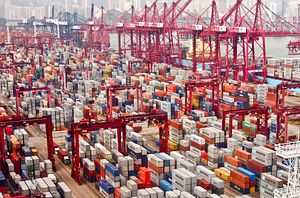On Tuesday, a spokesman for China’s Ministry of Commerce said that China is willing to complete negotiations on the China-Australia Free Trade Agreement soon. His remarks were the latest in a string of comments by both Chinese and Australian officials giving new life to a negotiation process that many had assumed was all but dead.
China and Australia opened talks over a potential Free Trade Agreement in May 2005. Since then, there have been 19 rounds of talks, with the most recent discussions concluding in June 2013. The talks have dragged on for over eight years due to hang-ups over agriculture exports, the service industry, and foreign investment. The Australian government is seeking the reduction or removal of tariffs on agricultural products as well as the service industry, concessions that the Chinese government has historically been reluctant to make. For its part, the Chinese government seeks to eliminate Australian tariffs on Chinese manufactured goods, and would also like a more receptive climate for foreign investments by Chinese companies. The competing demands essentially deadlocked the FTA negotiations for years, leading many to assume that there was no real hope for any agreement.
Now, however, both the Chinese and Australian governments have renewed their support for an FTA, and seem determined to push an agreement through in the next 12 months. “It’s time to sign the agreement,” said Australian Minister for Industry Ian Macfarlane during an early November visit to China. Macfarlane added that he hopes a comprehensive deal will be ready in time for Australian Prime Minister Tony Abbott’s visit to China in 2014. Abbott has also expressed his support for the FTA, although he has hinted that the deal might not be a comprehensive one. “I’ve always taken the view that you should take what you can get today and pitch for the rest tomorrow,” Abbott told reporters during the October APEC Summit in Bali. Meanwhile, when Chinese President Xi Jinping met with Australia’s Governor-General in early November, he listed completion of the China-Australia FTA as his first priority for China-Australia relations.
So why the sudden change?
For one thing, Australian Prime Minister Tony Abbott, who assumed office on September 18, is determined to increase ties between China and Australia. Former Prime Minister Julia Gillard, who held office from June 2010 – June 2013, placed more emphasis on Australia’s relationship with the U.S. Under her leadership, Australia agreed to host U.S. marines in the city of Darwin, a move that surprised and worried Chinese leaders. By contrast, Abbott has taken pains to repair Australia’s relationship with China. A renewed push for the FTA is one part of those efforts.
In addition, the Asia-Pacific region seems to have caught a general case of FTA fever, with numerous bilateral and multilateral free trade zones under negotiation. On a large scale, there is something of a race to complete two separate expansive multilateral agreements: the Trans-Pacific Partnership (which would include Australia, Brunei, Chile, Canada, Japan, Malaysia, Mexico, New Zealand, Peru, Singapore, the U.S., and Vietnam), and the Regional Comprehensive Economic Partnership (which covers ASEAN, Australia, China, India, Japan, New Zealand, and South Korea).
There’s been even more action on the bilateral front, as countries jockey for economic position in the region that the World Bank believes will continue to lead global growth. In addition to its talks with China, Australia is currently negotiating bilateral FTAs with India, Indonesia, Japan, and South Korea. China, meanwhile, is discussing FTAs with India, Japan, and South Korea.
With so many countries involved in negotiating FTAs, there is pressure to finalize those deals as quickly as possible. Otherwise, a rival economy might gain an edge in regional trade. University of Queensland Senior Lecturer in Economics James Laurenceson points out on his blog that New Zealand’s own FTA with China began to take effect in 2012 and 2013—not coincidentally, around the same time Australia’s government began a renewed push for a China-Australia agreement.
It’s something of a perfect storm in favor of the China-Australia FTA: a new China-focused administration in Australia combined with a general regional race for completed trade agreements. Still, as Prime Minister Abbott all but admitted, the completed FTA is likely to be less comprehensive than hoped. If the FTA is signed in 2014 as expected, it won’t signal a breakthrough in negotiations over tough issues like agricultural and manufacturing tariffs. Rather, it will be a symbol of renewed commitment to both China-Australia relations and free trade agreements in general.

































